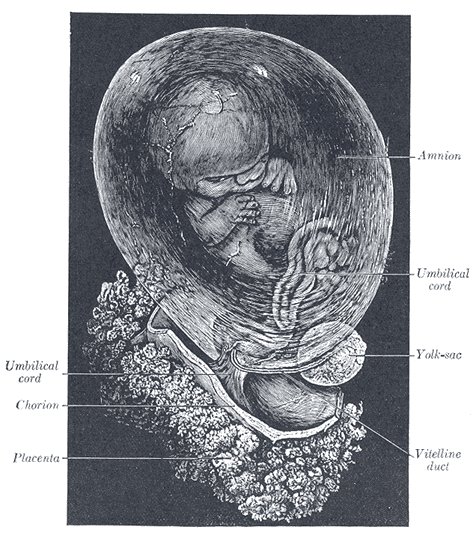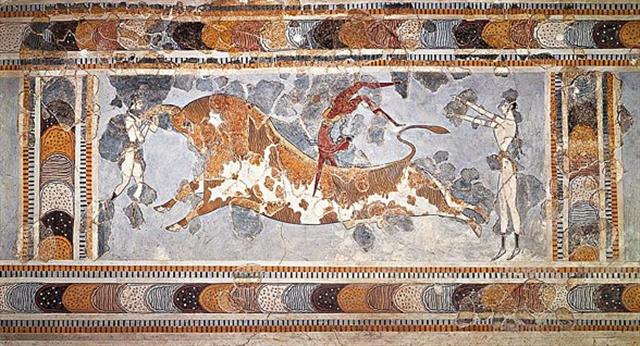Auriga is high up and Orion
is far down. 6h is at the northern midsummer
with the Sun high up and close to Auriga.
The Butting One (Elnath) could be the name
for the northern tip of the Bull's right
horn because here the Sun is pushed high.
Such thoughts may have inspired the ancient
Cretan sport of leaping over a bull with the
help of his horn:
The 3 figures, one at left,
one at right, and one making the daring jump
- potentially deadly (salto mortal) -
should be read from left to right -
following the events in time.
The reversed figure, standing
straight and tall, could illustrates how
beyond high summer there is a kind of mirror
reversal, with the high sky gradually
returning to normal again. The face of the
Sun is honoured by not turning your back to
him. In ancient China the emperor always sat
with his back towards the north.
In Minoan times (from ca 2600
BC to its end with the explosion of
Santorini ca 1600 BC) Elnath would have
risen with the Sun around [(2600 + 1600) / 2
+ 1843] / 71 = about 33 days earlier than in
rongorongo times. Not in June 9 (160) but in
day 160 - 33 = 127 or May 7. This was 172 -
127 = 45 days before midsummer.
Possibly the idea of a leap
day originated with Elnath. Symmetry could
then demand high summer should end
approximately 45 days after midsummer. Or ca
90 days after Elnath. May 7 + 90 = ca day
217 (August 5). 217 - 80 = RA day 137.
Anyhow, let's go back to my
description of glyph line Ga1. At present it continues
like this:
The Milky Way river was like
a barrier which the Sun, the great Fire in
the sky, would be unable to pass. Water
quenches fires. But there was a trick. He
could sire a new Sun (son) and when the new
Sun evolved into his proper shape inside his
shell - the Sun was a bird - he would be
protected from the watery environment.

We can perhaps interpret
Ga1-16 as a bird shell with a growing embryo
inside:
|
Eclipse sequence: |
 |
 |
 |
|
 |
 |
|
Ga1-15 |
Ga1-16 |
Ga1-17 |
Ga1-18 |
Ga1-19 |
|
λ Aurigae (79.0), λ Leporis
(79.6), ρ Aurigae (79.7)
Arcturus
|
σ Aurigae (80.4), Bellatrix,
Saif al Jabbar (80.7),
Elnath
(80.9) |
M38 (81.6), Nihal (81.7) |
Mintaka (82.4), χ Aurigae
(82.5), ε Columbae (82.6) |
Al Hak'ah-3 /
Mrigashīrsha-5 /
Turtle-20 |
|
Arneb,
Crab Nebula
(83.0,
φ╣ Orionis
(83.1),
HEKA
(83.2), Hatysa, M36 (83.5),
φ▓ Orionis
(83.6), Alnilam (83.7) |
|
June 8 |
9 (160) |
10 (*81) |
11 |
12 |
|
║June 4 |
5 (156) |
6 (314 / 2 = 157) |
7 (156 / 2 = *78) |
8 |
|
'May 12 |
13 (499) |
14 (*54) |
15 |
16 (136) |
|
"April 28 |
29 (485) |
30 (*40) |
"May 1 |
2 (122) |
|
ξ Ophiuchi (262.2), θ
Ophiuchi, ν Serpentis, ζ, ι
Apodis (262.4), ι Arae
(262.8), ρ Herculis (262.9) |
β, γ Arae (263.3), κ Arae
(263.5), σ Ophiuchi (263.6) |
Lesath, δ Arae (264.7), Choo
(264.9) |
Alwaid, Maasym (265.1),
Shaula
(265.3), Kuma
(265.6), σ Arae (265.9)
Hamal
|
Ras Alhague (266.1),
Sargas
(266.3), μ Ophiuchi, π Arae
(266.5), Nan Hae (266.6), ι
Herculis (266.7) |
|
December 8 |
9 |
10 |
11 (*265) |
12 (346) |
|
║December 4 |
5 |
6 (*260) |
7 |
8 (342) |
|
'November 11 |
12 (*236) |
13 |
14 (318) |
15 |
|
"October 28 |
29 (*222) |
30 (303) |
31 (*590) |
"November 1 |
Perhaps there were 2 ways to
cross the Milky Way river, one by following
the left horn of the Bull straight forward, protected by a shell, and the other
to make a daring leap using the
right horn of the Bull.
The straight forward way
leads to the tip of the left horn, to
Heavenly Gate,
to 'fucking', ζ Tauri:
 |
 |
|
Ga1-20 |
Ga1-21 |
|
Three Stars-21 /
ANA-IVA (7) |
ο Aurigae (85.8), γ Leporis
(85.9)
Yang
Mun
|
|
Heavenly Gate, ν Columbae
(84.0),
ALNITAK,
PHAKT
(Phaet) (84.7) |
|
June 13 (530) |
14 (165) |
|
║June 9 (160) |
10 (*81) |
|
'May 17 (137) |
18 (*58) |
|
"May 3 (*43) |
4
(490) |
|
λ
Arae (267.1),
Girtab,
ο Serpentis (267.6) |
Kelb Alrai, μ Arae (268.1), Kew
Ho (268.6), η Pavonis (268.7),
Apollyon
(268.9) |
|
December 13 (713) |
14 (*268) |
|
║December 9 (709) |
10 (344) |
|
'November 16 (*240) |
17 (321) |
|
"November 2 (*226) |
3 (307) |
|
Manacle |
ziqq |
Phoenician zayin |
 |
Greek zeta |
Ζ
(ζ) |
|
... Zeta (uppercase
Ζ,
lowercase
ζ;
Greek:
ζήτα
... is the sixth letter of the
Greek alphabet. In the system of
Greek numerals, it has a value
of 7. It was derived from the
Phoenician letter Zayin.
Letters that arose from zeta
include the Roman Z and Cyrillic
З
...
Zayin
(also spelled Zain or
Zayn or simply Zay)
is the seventh letter of many
Semitic abjads ... It represents
the sound [z].
The Phoenician letter appears to
be named after a sword or other
weapon. (In Biblical Hebrew, 'Zayin'
means sword, and the verb 'Lezayen'
means to arm. In modern Hebrew,
'zayin' means penis and 'lezayen'
is a vulgar term which generally
means to perform sexual
intercourse and is used in a
similar fashion to the English
word fuck, although the older
meaning survives in 'maavak
mezuyan' (armed struggle)
and 'beton mezuyan'
(armed, i.e., reinforced
concrete). The Proto-Sinaitic
glyph according to Brian Colless
may have been called ziqq,
based on a hieroglyph depicting
a 'manacle'. |
|



